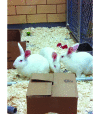The Social Nature of European Rabbits (Oryctolagus cuniculus)
- PMID: 27931309
- PMCID: PMC5113872
The Social Nature of European Rabbits (Oryctolagus cuniculus)
Abstract
Increasing concerns regarding the wellbeing of laboratory animals have caused biomedical research stakeholders to reconsider traditional housing of laboratory species and to provide social companionship for social species. European rabbits (Oryctolagus cuniculus) are commonly individually housed in research facilities despite the occurrence of social groups in the wild. Here we review the current literature to provide a comprehensive description of the social behaviors and preferences of rabbits in the wild and in captivity. The implications of these studies regarding social housing of laboratory rabbits are discussed.
Figures






References
-
- Albonetti ME, Dessi-Fulgheri F, Farabollini F. 1990. Intrafemale agonistic interactions in the domestic rabbit (Oryctolagus cuniculus L.). Aggress Behav 16:77–86.
-
- Albonetti ME, Dessi-Fulgheri F, Farabollini F. 1991. Organization of behavior in unfamiliar female rabbits. Aggress Behav 17:171–178.
-
- Albonetti ME, Farabollini F, Dess-Fulgheri F. 1988. The acquisition of social dominance in female rabbits. Monitore Zoologica Italiano 22:465–476.
-
- Andrist CA, Bigler LM, Wurbel H, Roth BA. 2012. Effects of group stability on aggression, stress, and injuries in breeding rabbits. Appl Anim Behav Sci 142:182–188.
-
- Arteaga L, Bautista A, Martínez-Gómez M, Nicolás L, Hudson R. 2008. Scent marking, dominance, and serum testosterone levels in male domestic rabbits. Physiol Behav 94:510–515. - PubMed
MeSH terms
LinkOut - more resources
Full Text Sources
